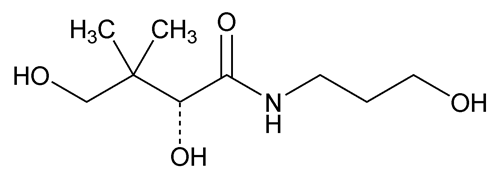Dexpanthenol
C9H19NO4205.25
Butanamide, 2,4-dihydroxy-N-(3-hydroxypropyl)-3,3-dimethyl-, (R)-;
d-(+)-2,4-Dihydroxy-N-(3-hydroxypropyl)-3,3-dimethylbutyramide

 [81-13-0].
[81-13-0].
(dex pan' the nol).
C9H19NO4205.25
Butanamide, 2,4-dihydroxy-N-(3-hydroxypropyl)-3,3-dimethyl-, (R)-;
d-(+)-2,4-Dihydroxy-N-(3-hydroxypropyl)-3,3-dimethylbutyramide
DEFINITION
Dexpanthenol contains NLT 98.0% and NMT 102.0% of dexpanthanol (C9H19NO4), calculated on the anhydrous basis.
IDENTIFICATION
• B.
Sample solution: 100 mg/mL of Dexpanthenol
Analysis: To 1 mL of the Sample solution add 5 mL of 1 N sodium hydroxide and 1 drop of cupric sulfate TS, and shake vigorously.
Acceptance criteria: A deep blue color develops.
• C.
Sample solution: 10 mg/mL of Dexpanthenol
Analysis: To 1 mL of the Sample solution add 1 mL of 1 N hydrochloric acid, and heat on a steam bath for 30 min. Cool, add 100 mg of hydroxylamine hydrochloride, and add 5 mL of 1 N sodium hydroxide. Allow to stand for 5 min, then adjust with 1 N hydrochloric acid to a pH of 2.5–3.0, and add 1 drop of ferric chloride TS.
Acceptance criteria: A purplish red color develops.
ASSAY
• Procedure
0.1 M potassium biphthalate: Transfer 20.42 g of potassium biphthalate into a 1000-mL volumetric flask, and add sufficient glacial acetic acid to dissolve. If necessary, warm the mixture on a steam bath to achieve complete solution, observing precautions against absorption of moisture. Cool to room temperature, and dilute with glacial acetic acid to volume.
Sample: 400 mg of Dexpanthenol
Blank: Proceed as directed in the Analysis, omitting the Sample.
Titrimetric system
(See Titrimetry  541
541 .)
.)
Mode: Residual titration
Titrant: 0.1 N perchloric acid VS
Back-titrant: 0.1 M potassium biphthalate
Endpoint detection: Visual
Analysis: Transfer the Sample to a 300-mL flask fitted to a reflux condenser by means of a standard-taper glass joint, add 50.0 mL of Titrant, and reflux for 5 h. Cool, observing precautions to prevent atmospheric moisture from entering the condenser, and rinse the condenser with glacial acetic acid, collecting the rinsings in the flask. To the flask, add 5 drops of crystal violet TS, and titrate with the Back-titrant to a blue-green endpoint. Perform the Blank determination.
Calculate the percentage of dexpanthenol (C9H19NO4) in the Sample taken:
Result = {[(VB  VS) × M × F]/W} × 100
VS) × M × F]/W} × 100
| VB | = | = Back-titrant volume consumed by the Blank (mL) |
| VS | = | = Back-titrant volume consumed by the Sample (mL) |
| M | = | = actual molarity of the Back-titrant (mM/mL) |
| F | = | = equivalency factor, 205.3 mg/mM |
| W | = | = Sample weight (mg) |
Acceptance criteria: 98.0%–102.0% on the anhydrous basis
IMPURITIES
• Residue on Ignition  281
281 : NMT 0.1%
: NMT 0.1%
• Limit of Aminopropanol
Sample: 5 g of Dexpanthenol
Blank: 10 mL of water
Titrimetric system
(See Titrimetry  541
541 .)
.)
Mode: Direct titration
Titrant: 0.1 N sulfuric acid VS
Endpoint detection: Visual
Analysis: Dissolve the Sample in 10 mL of water, and add bromothymol blue TS. Titrate with the Titrant to a yellow endpoint. Perform the Blank determination.
Calculate the percentage of aminopropanol in the Sample taken:
Result = {[(VS  VB) × N × F]/W} × 100
VB) × N × F]/W} × 100
| VS | = | = Titrant volume consumed by the Sample (mL) |
| VB | = | = Titrant volume consumed by the Blank (mL) |
| N | = | = actual normality of the Titrant (mEq/mL) |
| F | = | = equivalency factor, 75.11 mg/mEq |
| W | = | = Sample weight (mg) |
Acceptance criteria: NMT 1.0%
SPECIFIC TESTS
• Optical Rotation, Specific Rotation  781S
781S
Sample solution: 50 mg/mL in water
Acceptance criteria: +29.0 to +31.5
to +31.5
• Refractive Index  831
831 : 1.495–1.502, at 20
: 1.495–1.502, at 20
• Water Determination, Method I  921
921 : NMT 1.0%
: NMT 1.0%
ADDITIONAL REQUIREMENTS
• Packaging and Storage: Preserve in tight containers.
Auxiliary Information— Please check for your question in the FAQs before contacting USP.
| Topic/Question | Contact | Expert Committee |
|---|---|---|
| Monograph | Huy T. Dinh, M.S. Scientific Liaison 1-301-816-8594 | (DS2010) Monographs - Dietary Supplements |
| Reference Standards | RS Technical Services 1-301-816-8129 rstech@usp.org |
USP35–NF30 Page 2850
Chromatographic Column—
Chromatographic columns text is not derived from, and not part of, USP 35 or NF 30.

